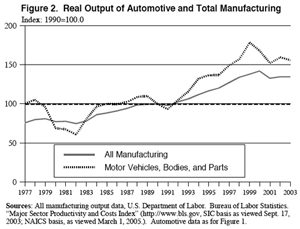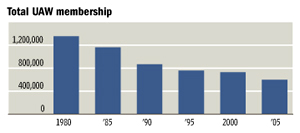The latest news from the Big Three (Chrysler, Ford, and GM) automakers is bad. As of Valentine’s Day — how appropriate for North American workers to receive another shot to the heart — the permanent force reduction now exceeds 100,000. Most of the jobs eliminated are hourly workers, UAW and CAW union members in fact (the majority of the job losses will take place in the US). UAW President Gettelfinger told the New York Times (2/15/07) that the news was “devastating . . . for thousands of workers, their families and their communities.” Buzz Hargrove of the CAW was quoted as “We’re saying to people, ‘You’d better take what you can,’.” These comments capture the long descent of the UAW, and more lately the CAW, from organizations inspiring collective action and rank-and-file planning, to organizations in retreat, recommending individual solutions and mouthing toothless platitudes.
Members will be further disheartened to hear such words from their leaders, knowing their non-union peers at Toyota, BMW, Honda, Nissan, etc. are facing no such cuts. And yet the workers at those plants will have little incentive to fight through layers of anti-union activity — from screening applicants to insure they have an anti-union attitude to consistent, internal, on-the-job campaigns directed at shoring up this attitude — to vote union. Too often UAW1 leaders use these facts to justify their seeming inability to organize outside the Big Three. But many UAW members know this is not all that stands in the way. The internal dynamics and ideological direction of the UAW plays an important role.
Click on the chart for a larger view. SOURCE: Stephen Cooney and Brent D. Yacobucci, “U.S. Automotive Industry: Policy Overview and Recent History,” Congressional Research Service, 25 April 2005
|
For those unfamiliar with UAW history, starting in early 1980s, the UAW signed on to a contractual program of labor-management cooperation, called “jointness.” Union leaders hoped this would save Big Three workers from the aggressive downsizing resulting from the “Japanese invasion.” Some of the social democratic UAW leaders even hoped this would morph into something like the German workplace co-determination (where it was codified into law). Twenty-five years later, it is clear that neither hope was realized. Today’s UAW members are producing more cars than they did in 1979 with less than half the number of people. By 1987 the national contracts of the Big Three2 had language which placed the priority of “securing the company’s market position” above the “job security of its employees.” The cornerstone of the UAW — equal pay for equal work — has given way to a workplace where there is no uniform pay and benefits (the “tier” system in manufacturing lingo). If workers do have a say in the workplace, it is likely to be about how to distribute the work of cut employees, never about how to keep or add workers.
Reversing these trends and changing course will not be easy given the entrenchment of the jointness ideology. The elements of renewal are not the stuff of rocket science, however, and are no doubt commonsense solutions for many of us both inside and outside unions3.
- Cooperation plans built on competitiveness only benefit the employer — they must be rejected. Time has proven they only result in fewer workers with more work. The very notion of competition between workers and working-class organization should never be mentioned in the same sentence; they are antithetical. Competition has easily bled over into worker against worker, too often with racist and xenophobic overtones. Some things never change — An Injury to One Is An Injury to All.
- Continue to oppose privatization and schemes that destroy public space and activity for the public good. In the UAW case, this means standing up to and not with the auto companies on fuel consumption, public transportation, and urban sprawl.
- Organizing new workers, especially in the auto industry, will take a long-term commitment to the community as well as to the workers in any particular workplace. Such a commitment might start with building a union/community hall and opening the doors to community groups and advocates who promote and defend the working class and their needs: tenants and “city” rights; immigration; programs to combat racism, sexism, and homophobia; teen centers, day care, elder care; unemployment — you get the drift. Only then will there be sufficient “goodwill” to overcome years of anti-union indoctrination. This approach will be even more crucial as the auto industry continues to relocate to the US south and southwest.
- Building organizations whose internal culture develops and appreciates grassroots leadership; helps members become the best people they can be, not just foot soldiers dedicated to the organization; works to eliminate the injuries of capitalism and understands the connectedness between issues of race, gender, and class; and gives members the tools to strategically plan and carry out their plans.
- Internationalism not paternalism (or worse, colonialism) with our sisters and brothers in other countries. We have something to learn from others struggles. Coordinated bargaining, strategizing, campaigns, and actions are a must in the neo-liberal global economy. When Brazilian and South African workers want to conduct activities at their workplace to help us in the US (as they offered the UAW), they must be embraced and return support actions developed. Even though the UAW was “officially” on the record against apartheid, they never promoted or encouraged workplace activities on this issue.
- The UAW or any other union- or working-class-based organization must be fully committed to expanding rights, not limiting them. As the old saying goes, if you don’t stand for something you’ll fall for anything. Despite pleas from many sources to only stick with economic issues, we need organizations that work hard on the tough issues like gay marriage. The UAW, for example, has a fairly stellar record on passing resolutions at conventions on these issues but rarely does the tough job of educating members and working vigorously with the community about them. Some of these issues need not be button pushers. Take universal health care. It is beyond belief that the UAW hasn’t thrown its entire apparatus behind the Conyers bill. Health care and pension costs are a significant factor in the Big Three woes.
- Do some serious thinking about issues of re-industrialization.
Unfortunately, it may be too optimistic to think that this latest news will jumpstart a long overdue self-reflection and program of correction. Without such a step, the UAW membership will continue to slide, its ability to defend workers narrowed, and its prospects for growth dimmed. This should give pause to those in or being organized by SEIU, whose President Andy Stern has continued to trumpet a version of this ideology of partnership with an employers who show little or no interest in the wellbeing of workers.
1 Although there are increasing similarities between the CAW and UAW, the CAW and Canadian union internal culture and history, as well as Canadian labor law, necessitates a separate piece. C’mon sisters and brothers in Canada, use your experience to weigh in on these vital questions.
2 In the UAW there is a master agreement which covers wages, broad union rights, benefits, and the outlines of a seniority system. Local agreements fill in the blanks and discuss specific local conditions (like hours of work, holidays above and beyond those in the master contract, numbers and types of different jobs).
3 The similarities between these ideas and those contained in the Center for Labor Renewal‘s Call are not accidental. Join us today.
Elly Leary, a former autoworker whose plant closed, retired from UAW 2324 at Boston University, where she was vice-president and chief negotiator.
|
| Print

